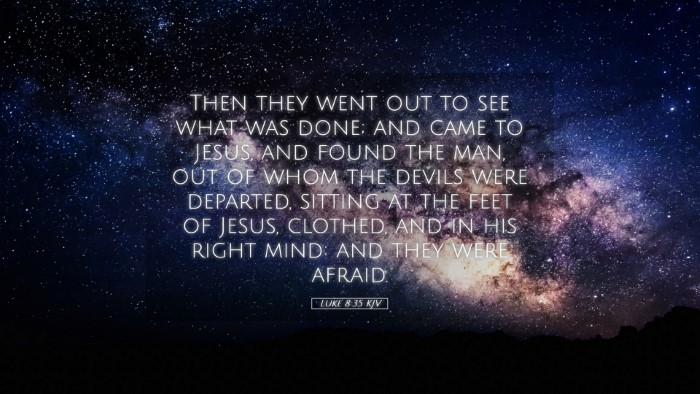Commentary on Luke 8:35
Verse: "Then they went out to see what was done; and came to Jesus, and found the man, out of whom the devils were departed, sitting at the feet of Jesus, clothed, and in his right mind: and they were afraid."
Introduction
This verse captures a pivotal moment following the miraculous healing of the Gerasene demoniac. It illustrates the transformative power of Jesus and the varied responses of those who witness such a miracle. Commentaries from early theologians such as Matthew Henry, Albert Barnes, and Adam Clarke provide rich insights into this passage for pastors, students, and theologians alike.
Context of the Passage
Prior to this event, Jesus had crossed the Sea of Galilee, leading to His encounter with a man possessed by demons. This man's deliverance not only showcases Jesus' authority over evil spirits but also serves as a testimony to His role as the Messiah. The reaction of the local populace, including their fear and rejection, speaks volumes about the nature of faith and the challenges of belief.
Analyses of Key Elements
-
1. The Search for Understanding
In the phrase, “Then they went out to see what was done,” we observe a natural inclination of the spectators to seek understanding. Matthew Henry notes that the people were drawn out of genuine curiosity and perhaps a lack of comprehension regarding the miracle they had just witnessed.
-
2. The Transformed Man
“The man, out of whom the devils were departed,” represents the power of Jesus in restoring not only bodily health but also mental stability. Albert Barnes emphasizes the significance of the man being “sitting at the feet of Jesus,” indicating a position of learning and devotion. This displays the peace and calm that comes after Christ's intervention—contrasting sharply with his prior chaotic existence.
-
3. Clothing and Identity
The detail that the man was “clothed” signifies restored dignity. Adam Clarke elaborates that clothing here symbolizes the social restoration and a new status among the community. It emphasizes how Jesus not only fulfills spiritual needs but addresses social and personal stigmas.
-
4. In His Right Mind
To be “in his right mind” reveals the comprehensive nature of the healing. Matthew Henry points out that this underscores the transformative power of Christ, affecting both the spirit and the psyche of the man. It also signifies restoration of normalcy to his life, which previously was dominated by darkness.
-
5. The Fear of the Onlookers
Despite witnessing a remarkable miracle, the response of the local people—“and they were afraid”—is a profound commentary on human nature. Albert Barnes notes that fear often arises from the unknown; they may have felt overwhelmed by the divine power manifested in front of them. The fear revealed their inability to grasp the enormity of what had occurred.
Theological Implications
This passage offers several theological insights:
- Authority of Christ: The transformation of the demoniac confirms Jesus' absolute power over evil and chaos, affirming His divinity and authority.
- Restoration and Redemption: The restorative action of Jesus shows His desire to redeem humanity from spiritual and emotional bondage, inviting believers to find peace in Him.
- Human Responses to the Divine: The fear of the onlookers challenges believers today to ponder their own responses to the presence and power of God. It questions whether they react with faith, skepticism, or fear.
Pastoral Applications
Pastors can draw several applications from this text:
- Encouragement of Transformation: Share testimonies of transformation, emphasizing how no one is beyond the reach of God’s grace.
- Empathy for the Broken: Develop a ministry that reaches out to those who are spiritually afflicted or marginalized, following the example of Jesus in restoring dignity.
- Embrace of Fear: Address the fear that congregants may have regarding divine power, encouraging them to trust in God rather than allowing fear to paralyze faith.
Conclusion
Luke 8:35 is a profound narrative that encapsulates the essence of Jesus’ ministry. Through the lens of public domain commentaries, we see a multifaceted view of the text that engages theological reflection and practical application. As pastors, students, and scholars engage with this verse, they are invited into deeper understanding and contemplation of Christ’s transformative power and the human condition.


